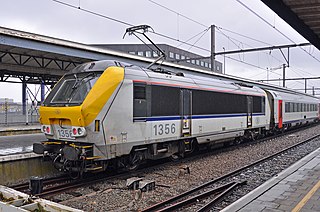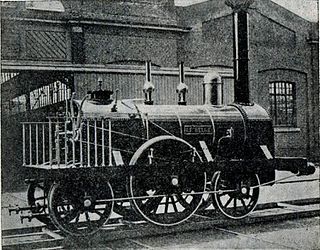
Transport in Belgium is facilitated with well-developed road, air, rail and water networks. The rail network has 2,950 km (1,830 mi) of electrified tracks. There are 118,414 km (73,579 mi) of roads, among which there are 1,747 km (1,086 mi) of motorways, 13,892 km (8,632 mi) of main roads and 102,775 km (63,861 mi) of other paved roads. There is also a well-developed urban rail network in Brussels, Antwerp, Ghent and Charleroi. The ports of Antwerp and Bruges-Zeebrugge are two of the biggest seaports in Europe. Brussels Airport is Belgium's biggest airport.
The National Railway Company of Belgium is the national railway company of Belgium. The company formally styles itself using the Dutch and French abbreviations NMBS/SNCB. The corporate logo designed in 1936 by Henry van de Velde consists of the linguistically neutral letter B in a horizontal oval.

An electric locomotive is a locomotive powered by electricity from overhead lines, a third rail or on-board energy storage such as a battery or a supercapacitor. Locomotives with on-board fuelled prime movers, such as diesel engines or gas turbines, are classed as diesel-electric or gas turbine-electric and not as electric locomotives, because the electric generator/motor combination serves only as a power transmission system.

Railway electrification is the use of electric power for the propulsion of rail transport. Electric railways use either electric locomotives, electric multiple units or both. Electricity is typically generated in large and relatively efficient generating stations, transmitted to the railway network and distributed to the trains. Some electric railways have their own dedicated generating stations and transmission lines, but most purchase power from an electric utility. The railway usually provides its own distribution lines, switches, and transformers.

Railway electrification systems using alternating current (AC) at 25 kilovolts (kV) are used worldwide, especially for high-speed rail. It is usually supplied at the standard utility frequency, which simplifies traction substations. The development of 25 kV AC electrification is closely connected with that of successfully using utility frequency.

The HSL 2 is a Belgian high-speed rail line between Leuven and Ans and is 66.2 km (41 mi) long, all of it on dedicated high-speed tracks, which began service on 15 December 2002. As part of the Belgian railway network, it is owned, technically operated and maintained by Infrabel.

Infrabel is a Belgian government-owned public limited company. It builds, owns, maintains and upgrades the Belgian railway network, makes its capacity available to railway operator companies, and handles train traffic control.

Aachen Hauptbahnhof is the most important railway station for the city of Aachen, in the far west of Germany near the Dutch and Belgian border. It is the largest of the four currently active Aachen stations, and is integrated into the long-distance network.

Rail transport in the Netherlands uses a dense railway network which connects nearly all major towns and cities. There are as many train stations as there are municipalities in the Netherlands. The network totals 3,223 route km (2,003 mi) on 6,830 kilometres (4,240 mi) of track; a line may run both ways, or two lines may run on major routes. Three-quarters of the lines have been electrified.

Rail transport in France is marked by a clear predominance of passenger traffic, driven in particular by high-speed rail. The SNCF, the national state-owned railway company, operates most of the passenger and freight services on the national network managed by its subsidiary SNCF Réseau. France currently operates the second-largest European railway network, with a total of 29,901 kilometres of railway.

Rail transport in Europe is characterized by the diversity of technological standards, operating concepts, and infrastructures. Common features are the widespread deployment of standard-gauge rail, high operational safety and a high share of electrification. Electrified railway networks operate at a plethora of different voltages AC and DC varying from 750 to 25,000 volts, and signaling systems vary from country to country, complicating cross-border traffic.

Rail transport in Slovakia began on September 21, 1840, with the opening of the first horse-powered line from Bratislava to Svätý Jur. The first steam-powered line, from Bratislava to Vienna, opened on August 20, 1848.

The Class 13 are a type of mixed use 200 km/h (124 mph) multivoltage electric locomotive of type Traxis designed by Alstom in the late 1990s for the Belgian and Luxembourgish railways.

The Polish railways network consists of around 18,510 kilometres (11,500 mi) of track as of 2019, of which 11,998 km (7,455 mi) is electrified. The national electrification system runs at 3 kV DC.

The Trenitalia ETR 700, originally NS Hispeed V250, is a high-speed train designed by Pininfarina and built by AnsaldoBreda originally for NS International and NMBS/SNCB to operate on the Fyra service, a high speed train between Amsterdam and Brussels with a branch to Breda on the newly built HSL-Zuid in the Netherlands and its extension HSL 4 in Belgium.

Belgium was heavily involved in the early development of railway transport. Belgium was the second country in Europe, after Great Britain, to open a railway and produce locomotives. The first line, between the cities of Brussels and Mechelen opened in 1835. Belgium was the first state in Europe to create a national railway network and the first to possess a nationalised railway system. The network expanded fast as Belgium industrialised, and by the early 20th century was increasingly under state-control. The nationalised railways, under the umbrella organisation National Railway Company of Belgium (NMBS/SNCB), retained their monopoly until liberalisation in the 2000s.

The class 96 is an electric multiple unit constructed in 1996 for the National Railway Company of Belgium.

The NMBS/SNCB Type 36 was a class of 2-10-0 Decapod steam locomotives built from 1909 to 1914 for heavy freight service in Belgium operated by the National Railway Company of Belgium.

Hasselt-Maastricht railway is a railway track that goes from the Y-intersection Beverst with the Hasselt-Liège railway from Hasselt to Maastricht. The line is 17.2 km (10.7 mi) long.

Series 54, were diesel locomotives used by the National Railway Company of Belgium (NMBS/SNCB). Along with Series 52, 53 and 59, they were the first generation of Belgian diesel locomotives, built in the 1950s. All three types were ultimately derived from the earlier Series 52 locos, representing a faster version of the design, allowing for 140 km/h usage instead of 120 km/h.




















